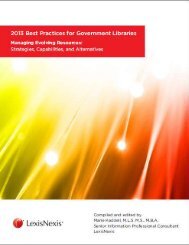2012 Best Practices for Government Libraries
2012 Best Practices for Government Libraries
2012 Best Practices for Government Libraries
Create successful ePaper yourself
Turn your PDF publications into a flip-book with our unique Google optimized e-Paper software.
Overview<br />
<strong>Government</strong> agencies and corporations are investing millions of dollars in “big data” technology plat<strong>for</strong>ms. Their primary<br />
focus is on storing and extracting value from very large volumes of a wide variety of data—from back-end systems, data<br />
warehouses, digital sources, Internet research, etc. But a key consideration often overlooked is the need <strong>for</strong> third-party<br />
data that complements this data in order to enable comparative modeling and corroboration. LexisNexis ® aggregates<br />
tens of thousands of news, business, legal, public records, and patent sources, serving as a comprehensive supplier of<br />
third-party, trusted data to help organizations leverage their big data technology investments.<br />
(LexisNexis business, news, and public<br />
records and social media data)<br />
Social Media<br />
content<br />
External Open Source<br />
aggregated and<br />
trusted content<br />
Unlocking the Value of Big Data<br />
As the hype over big data continues, technology<br />
plat<strong>for</strong>m providers are touting the benefits of big data<br />
analytics and integration in the hopes of capitalizing<br />
on this fast-growing market. McKinsey Global Institute<br />
summarized these benefits in a 2011 report, noting the<br />
“… five broad ways in which using big data can create<br />
value. First, big data can unlock significant value by<br />
making in<strong>for</strong>mation transparent and usable at much<br />
higher frequency. Second, as organizations create<br />
and store more transactional data in digital <strong>for</strong>m, they<br />
can collect more accurate and detailed per<strong>for</strong>mance<br />
in<strong>for</strong>mation on everything from product inventories to<br />
sick days, and there<strong>for</strong>e expose variability and boost<br />
per<strong>for</strong>mance. Third, big data allows ever-narrower<br />
segmentation of customers and there<strong>for</strong>e much<br />
more precisely tailored products or services. Fourth,<br />
sophisticated analytics can substantially improve<br />
decision making. Finally, big data can be used to improve<br />
the development of the next generation of products<br />
and services.” 1<br />
Of course, business intelligence gleaned from purely<br />
internal data reveals only a partial picture of key trends<br />
and events. It is critical to combine internal data with<br />
external data to truly extract the whole picture and gain<br />
the full value of big data.<br />
Internal Business<br />
Unit–Specific<br />
B i g D at a S o u rc e s<br />
Big Data<br />
Technology<br />
External Private<br />
Datafeed e.g.,<br />
supplier data,<br />
shared sensor data<br />
Enhancing the Value of Big Data<br />
Internal<br />
Enterprise Data<br />
Big data technology plat<strong>for</strong>m providers and the<br />
organizations they are targeting are focused on the<br />
storage, management, and analytics of large volumes<br />
of data. They are overlooking the importance and value<br />
of additional third-party data—not only to corroborate<br />
the data they have, but also to enhance the context<br />
of the data.<br />
A leading provider of third-party big data is LexisNexis,<br />
with data aggregated from more than 26,000 news<br />
and business sources, many exclusive to LexisNexis,<br />
as well as 6,500 unique international sources, 600+<br />
wire services, 6,000+ magazines, and more than 4,000<br />
premier Weblogs. LexisNexis offers full-text, same-day<br />
and archival coverage from major U.S. publications,<br />
including The Washington Post ® program transcripts<br />
from leading news networks; thousands of company<br />
reports on public and private businesses; and analysis<br />
from Dun & Bradstreet ® , Dow Jones ® , Hoover’s ® ,<br />
Standard & Poor’s ® , and Moody’s ® . And while many data<br />
providers may attempt to extract or download data<br />
from the open Web, LexisNexis has actually licensed<br />
its content. Licensed content is normalized, indexed,<br />
and stored, rendering LexisNexis content more easily<br />
discoverable and analyzable.<br />
Leveraging Your Big Data Technology Investment



